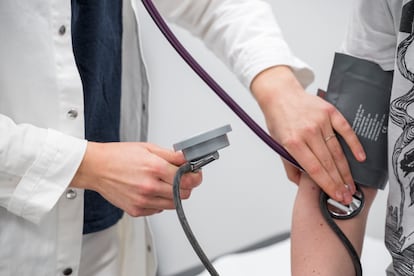Incorrect arm positioning can lead to false hypertension diagnoses: ‘We make mistakes in measuring blood pressure more often than not’
Common mistakes include failures to ensure a calm environment and that patients remain seated five minutes prior to their test

High blood pressure affects more than one billion adults, is the primary health risk factor among those over 49 years old, and is responsible for nearly 11 million deaths every year around the world. In the United States, the Centers for Disease Control and Prevention have found that nearly 500,000 people die every year from the condition. This state of affairs is similar to that of Spain. “In our country, you can go by the 50% rule,” says Doctor Manuel Anguita, a cardiologist at the Reina Sofía Hospital in Córdoba. “Approximately 50% of the population over the age of 45 [in the United States, the same figure is true for those over 20] has hypertension. Of that percentage, 50% don’t know they have it, and among those who do, 50% don’t have it under control or don’t have their blood pressure within an adequate range.”
As indicated by Anguita, who is a member of the Spanish Cardiological Society, medical associations and clinical practice guides recommend that if you’re between 40 and 45 years old — or even earlier, if you have family history of hypertension or cardiovascular disease — you should get your blood pressure measured at least once a year, in addition to taking advantage of every doctor’s visit to put the cuff on.
Such measures are crucial, Anguita says, because arterial hypertension has become a “silent killer”: though its symptoms can be slight, if it’s not treated, over time “it affects the heart, the brain, the kidney, and in general, the entire arterial tree. Hypertension is the most frequent cause of chronic renal failure, which is itself among the most frequent causes of heart failure and stroke, in addition to being a primary risk factor for myocardial infarction.”
But as important as measuring one’s blood pressure is, it’s just as important to make sure that it’s being measured correctly — which often, is not the case. “Currently, we’re measuring blood pressure inaccurately as much as 60% of the time, whether it’s done at the consulting office or at home. We make mistakes in measuring blood pressure more often than not,” says José Antonio García Donaire, president of the Spanish Hypertension Society.
According to the European Society of Hypertension practice guidelines for office and out-of-office blood pressure measurement, blood pressure should be measured in a calm environment, without speaking with the patient during or between measurements. The patient should remain seated and relaxed for three to five minutes before their measurement is taken, and should not have smoked, consumed caffeine, eaten or done any physical exercise during the 30 minutes previous to the measurement. Posture is also key: the patient must be seated with their back resting against the back of their chair, their legs uncrossed, their feet resting on the ground and their arm resting on a table at the same height as their heart.
“When you get a blood test, the results are objective. But blood pressure is constantly changing, so any deviation from these recommendations may cause that measurement to be incorrect,” says Donaire. A study that was recently published in the scientific journal JAMA Internal Medicine analyzing the influence that arm position has on blood pressure tests confirms this. According to its results, two commonly used techniques — supporting the arm on the lap and letting the arm hang without support — can lead to a hypertension misdiagnosis. Researchers found that resting the arm on the lap caused an overestimation of systolic pressure (the top number in a blood pressure reading) and diastolic pressure (the bottom number) by four millimeters of mercury; whereas an unsupported arm hanging at the side overestimated systolic pressure by almost seven and diastolic pressure by four.
Normal blood pressure is usually 120 millimeters of mercury for diastolic pressure and 80 for systolic pressure. In Europe, 140/90 and above is currently diagnosed as hypertension. “What this study shows is that if you measure blood pressure constantly in an erroneous way, with an unsupported arm, that gives you a measurement that is overestimated by almost seven millimeters of mercury, a potential difference between a systolic blood pressure of 142 and another of 135. In other words, it’s the difference between a patient being diagnosed with hypertension or not,” says Anguita.
Based on the study’s results, its authors warn that incorrect positioning of the arm will result in 16% of U.S. adults — the equivalent of 40 million people — being misdiagnosed as hypertensive when 140 millimeters of mercury of diastolic pressure is used as the cut-off point. Donaire, who is the head of the Arterial Hypertension Unit of the San Carlos de Madrid Clinical Hospital, says that a misdiagnosis leads to giving patients unnecessary medication and requiring superfluous follow-up visits. “Imagine an 80-year-old woman who is wrongly diagnosed with hypertension. It is possible that prescribing her the treatment, along with drugs she is already taking, could cause her to fall down and break her hip,” Donaire says.
Alternatives: time and home measurements
“So much emphasis being placed on this issue in clinical practice guidelines is due to the fact that to this day, not everyone measures blood pressure correctly,” says Miguel Ángel María Tablado, the coordinator of the Spanish Society of Family and Community Medicine’s working group on arterial hypertension. Tablado also points out the “white coat” effect, which refers to how patients can become more nervous upon entering a consulting office, which can increase their blood pressure. To counterbalance this phenomenon, Tablado recommends adhering to another basic recommendation for measurements: take three readings and use the average of the last two as the final result.
The European Society of Hypertension’s guide also recommends never making a diagnosis in a single consultation, unless the patient shows levels over 180/110 mmHG, or if there is evidence of injury to target organs such as the heart, kidney, retina, or brain.
“We have a short amount of time per patient and are very stretched, but we have to know how to stop for five minutes. It is worth taking the necessary time and doing it well rather than rushing to report a random number that can only confuse and lead to poor patient control, giving them drugs that they do not need or that are ineffective,” says Donaire. He adds that many professionals in the field have been speaking at conferences for years on the benefit of patients taking their measurements at home. “We see the patient for a few minutes in the consultation room, but if the patient has been taking their blood pressure for three or four months correctly, that will give us a much more reliable blood pressure assessment when it comes to treatment and control than I can obtain in the office, no matter how well I do it,” he says.
Anguita shares this opinion, and points out that several studies have indicated the technique known as ambulatory blood pressure monitoring “is more trustworthy and representative” of the patient’s real blood pressure, as compared to measurements taken in the consulting room. “If you have doubts and you’re unsure, it’s best for the patient to measure their pressure at home, with a well-calibrated apparatus, having been properly briefed on how to do it, using a holter,” says Anguita, who urges medical associations to educate their members on how to correctly measure blood pressure. “Many times, we teach about unusual and complex issues, and simple procedures are not emphasized. This study is a wake-up call for us to pay more attention,” he says.
Sign up for our weekly newsletter to get more English-language news coverage from EL PAÍS USA Edition
Tu suscripción se está usando en otro dispositivo
¿Quieres añadir otro usuario a tu suscripción?
Si continúas leyendo en este dispositivo, no se podrá leer en el otro.
FlechaTu suscripción se está usando en otro dispositivo y solo puedes acceder a EL PAÍS desde un dispositivo a la vez.
Si quieres compartir tu cuenta, cambia tu suscripción a la modalidad Premium, así podrás añadir otro usuario. Cada uno accederá con su propia cuenta de email, lo que os permitirá personalizar vuestra experiencia en EL PAÍS.
¿Tienes una suscripción de empresa? Accede aquí para contratar más cuentas.
En el caso de no saber quién está usando tu cuenta, te recomendamos cambiar tu contraseña aquí.
Si decides continuar compartiendo tu cuenta, este mensaje se mostrará en tu dispositivo y en el de la otra persona que está usando tu cuenta de forma indefinida, afectando a tu experiencia de lectura. Puedes consultar aquí los términos y condiciones de la suscripción digital.
More information
Archived In
Últimas noticias
Most viewed
- Sinaloa Cartel war is taking its toll on Los Chapitos
- Oona Chaplin: ‘I told James Cameron that I was living in a treehouse and starting a permaculture project with a friend’
- Reinhard Genzel, Nobel laureate in physics: ‘One-minute videos will never give you the truth’
- Why the price of coffee has skyrocketed: from Brazilian plantations to specialty coffee houses
- Silver prices are going crazy: This is what’s fueling the rally











































